New Song Released on History of Hindu India
Hinduism Today is pleased to announce the release of their first history movie music video, “Let’s Go Back 6,000 Years.” The Indus Valley Civilization is the song’s subject. It a song for children intended to supplement the popular History of Hindu India documentary “From Ancient Times.” In the course of our extended involvement with the California textbooks and the teaching of the history of India and Hinduism in California middle schools, we found out that music videos like this are very much appreciated by teachers for their classes. They serve as an appealing summary of the lesson material.
The song is the first of three being worked on for this time period.
Produced by: Hinduism Today
Music: Aks and Lakshmi
Lyrics: Dragan Stojkovski
Video and subtitles: Artyom Kuchma
Funding: Uberoi Foundatio
Hinduism Today Oct/Nov/Dec, 2018 Issue Released!
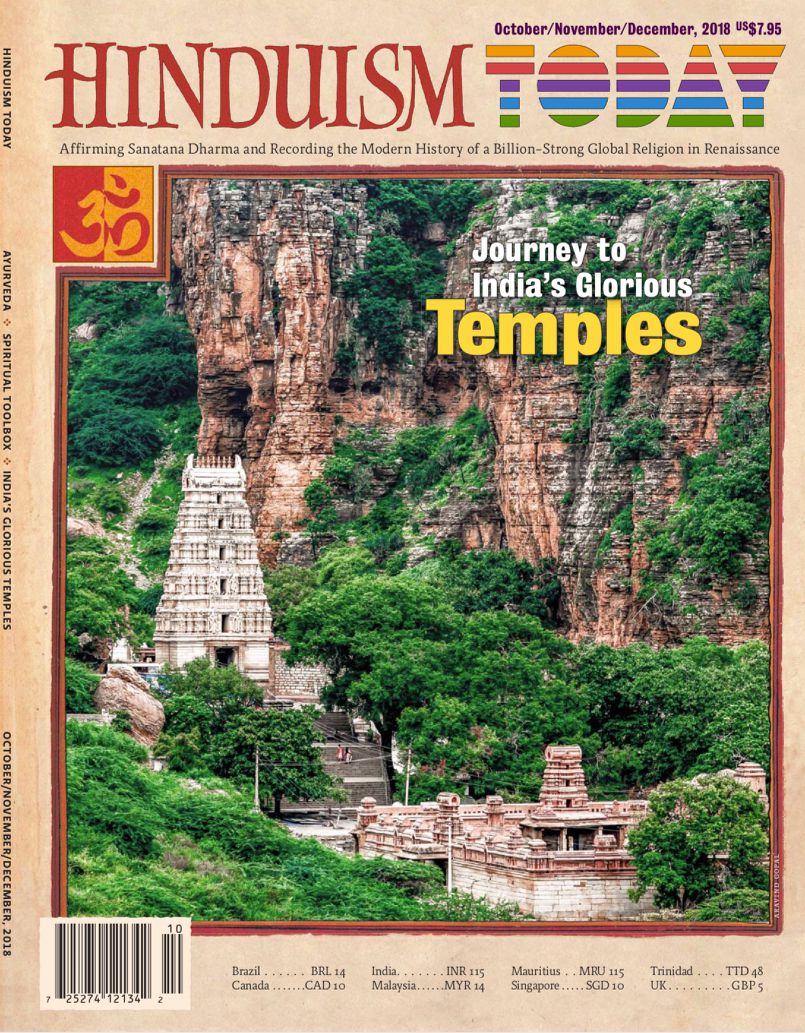
Jai Ganesha!
Hinduism Today's latest issue has gone to press and is now available online free of charge at:
www.hinduismtoday.com
You can also download our free Hinduism Today app and get the entire magazine in a mobile-friendly format for your device here.
In this issue's Publisher's Desk editorial, Satguru Bodhinatha Veylanswami addresses how we can enhance the peace and contentment in our life. He gives a number of effective techniques for the individual and for members of the household. Especially useful are his guidelines for a reduced-stressed existence achieved by living in the eternal now, and not bringing stress and contention into the home.
Peace and Contentment – Publisher’s Desk
Satguru Bodhinatha Veylanswami reads his editorial from the October/November/December 2018 edition of Hinduism Today magazine. "A look at some specific suggestions on what we can do to experience the peaceful state of mind called contentment"
Another Russian Issue Roles Off the Press
Today our magazine editors received a box of the latest issue of Hinduism Today to be printed in the Russian language. Our sincere thanks to Dinanatha and his team in Russia for their sincere and successful efforts to bring Hinduism Today to the Russian people. Aum Namah Sivaya
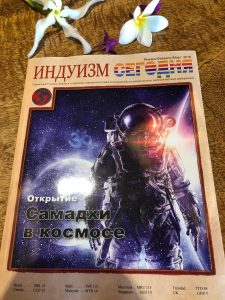
Reading One’s Own Inner Book
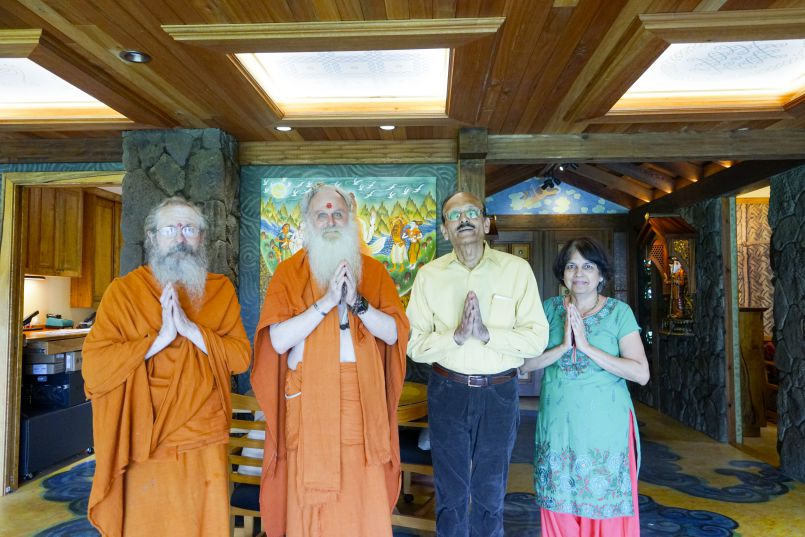
This phase, our monastery was delighted to meet long-time acquaintances for the first time, Mukund and Vaijayanti Hanumante of New Orleans, USA. Here they are with Paramacharya Sadasivanathaswami and Kaivalyanathaswami, visiting the Media Studio. They are Hinduism Today lifetime subscribers since the mid 1980s and generous donors to Iraivan temple. Mukund has also been a faithful advertiser for past 30 years, advertising his books. The first was A Glimpse of Divinity, which Gurudeva was so impressed with that he contacted Mukund and wrote a glowing review of it which is now part of the book. We know of no other instance when Gurudeva did such a thing. Mukund has since written a second book, Eternal Friend, which posits that we all carry within us a being longing to be our best, loyal and perfect friend forever, waiting patiently, and waiting for us to give the ok. When asked whether he plans a third book, he said, "For now, I am concentrating on reading my own inner book."
The Art of Listening – Publisher’s Desk
Satguru Bodhinatha Veylanswami reads an older editorial from the July/August/September 2015 edition of Hinduism Today magazine. "With the modern distraction of digital media, we must be more mindful than ever of person-to-person communications. Sound is regarded as divine in Hinduism, so it is fitting that listening has always held a central role in the faith. Our core scriptures, the Vedas and Agamas, are referred to as shruti, which means “that which is heard,” as they were originally heard by rishis as an aural transmission directly from God. In the early days of human civilization, prior even to writing, shruti was faithfully preserved without alteration (important because this is the word of God) by means of aural instruction from guru to shishya. This went on generation after generation for thousands of years. Considering the vast body of texts, it is remarkable that this was achieved, and more remarkable still when you know it was accomplished by requiring students to learn each verse in eleven different ways, including backwards."
Achieving Affectionate Detachment
Satguru Bodhinatha Veylanswami reads his upcoming editorial from the Jul/Aug/Sep 2018 edition of Hinduism Today magazine. "That completes the process of achieving affectionate detachment. We start with unaffectionate attachment and then move to unaffectionate detachment. From there we move to affectionate detachment, which comes in two stages. The first stage is expressing more love and kindness towards others. The second stage is understanding others more clearly, cognizing the nature of family, friends and acquaintances in an intuitive way, from the inside out, and therefore loving them more and being able to get along with them better. The deeper truth is that we are learning about ourself the whole time, and our inner changes are reflected in our relationships."
Who Gets to Enter Hindu Temples?
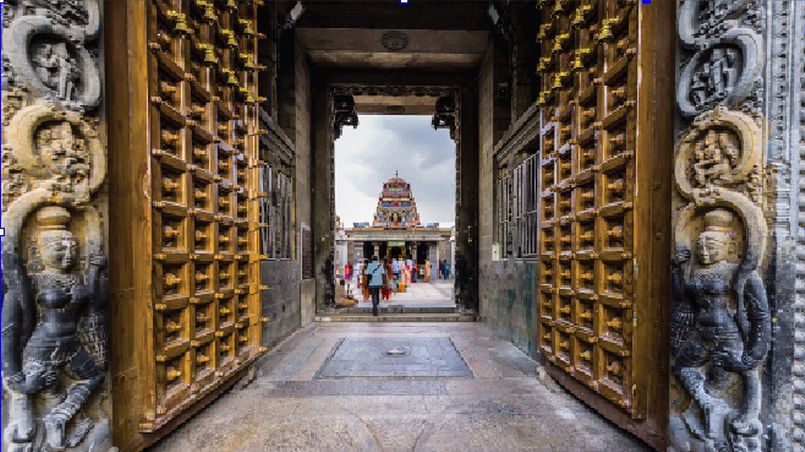
In the January/February/March issue of Hinduism Today Sheela Venkatakrishnan shares an experience of being denied entry to one of her favorite temples. Not herself, but two monks she was with that day in July as they sought to worship God Siva at the Kapaleeswarar Temple in Mylapore. That denial of entry to pure and wholehearted Hindus did not sit well with Sheela and she wrote passionately about it:
"In my hometown of Chennai, I was visiting an ancient Siva temple with two monks who had traveled thousands of miles to worship at this renowned pilgrimage destination. One, brown-skinned with Tamil features, was clad in the orange robes of a sannyasin. The other, wearing the yellow robes of a yogi, was white-skinned, light-eyed, obviously not Tamil or even Indian. A small group of us waited eagerly to have darshan of the Gods in this famous temple in the presence of these two monks from the Kauai Aadheenam in Hawaii. A special ticket can give access to the inner shrine, nearer to the Lord. But on this day no access would be permitted for the yogi. The priest denied him entrance. If he could not go in, how could any of us? So, we had our darshan from the outer mandapam. The priest took our offerings to the Lord, performed arati and brought out the flame for us.
"Who decides these things? Here I attempt to express my feelings and thoughts surrounding what occurred, hoping to find solace for my aching heart and, ideally, contribute to finding a resolution to what seems to me to be a critical issue in the Hindu community."
For the author's full appraisal of this happening, stay tuned to Hinduismtoday.com
Hinduism Today Makes Russian Issue
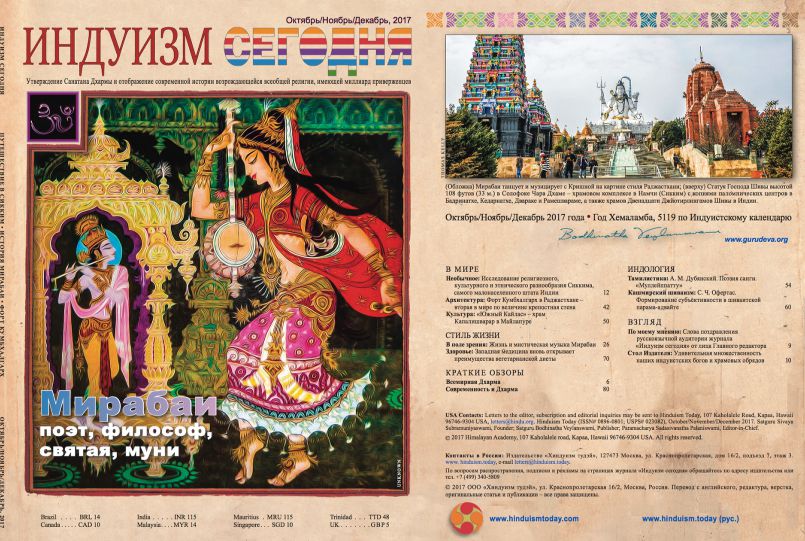
It's true, the first complete edition of our flagship magazine, Hinduism Today, has been published in the Russian language. It makes the international magazine potentially available to 166 million native speakers in that noble nation. Many do not know that a serious group of academics, and many non-scholarly citizens, regard Saivism as the original spiritual path in Russia, and they point to ancient Sivalingams and place of worship, and to philosophical footprints in history. Yesterday we received the second photo in the post from our Moscow editor Dinanatha Bodhiswami. It shows him at the famed French Institute in Pondicherry officially handing over the magazine to the experts there.
It took an immense effort and great teamwork to produce this edition, and an artistic eye to preserve the graphic sophistication and typography (nevermind making it all fit!). Congratulations to all who participated. Gurudeva would be thrilled to see this, and would offer his prayerful blessings that the magazine will continue for years to come in this newest incarnation. If you know someone who speaks the language, you can invite them to download the entire edition from this Dropbox link.
Welcome to Kannada

When she and her family visited in December, Shashikala Raja, of Michigan, learned that we have Satguru's publisher's Desk editorials translated into a number of Indic languages, but we were missing Kannada. She volunteered to be our translator, and upon returning home quickly submitted the first one, "One God, Many Divinities." It is now online and can be read here: https://www.hinduismtoday.com/modules/smartsection/item.php?itemid=5842
Kannada is the native language of nearly 40 million, most of whom are living in Karnataka state, where out Iraivan Temple carving site is located. So now the sculptors can listen to Satguru's wisdom.
Thank you, Shashikala, for opening the great Hindu heart and wisdom to a new and massive community. Below is the opening paragraph of the first translation, so all can enjoy the beauty of the script...
ಇತ್ತೀಚೆಗೆ ನಾನು ಲಂಡನ್ನಿನಲ್ಲಿರುವ ಎನ್ ಫೀಲ್ಡ್ ನಾಗಪೂಶನಿ ಅಂಬಾಳ್(ಅಂಬಿಕೆ)ಳ ದೇವಸ್ಥಾನದ ಮಹಾ ಕುಂಭಾಭಿಷೇಕದ ಸಂದರ್ಭದಲ್ಲಿ ಉಪನ್ಯಾಸ ಮಾಡಿದೆ. ಆ ಸಂದರ್ಭದಲ್ಲಿ ನೆರೆದಿದ್ದ ಅನೇಕರು ಹಿಂದೂಧರ್ಮಕ್ಕೆ ಹೊಸಬರಾಗಿದ್ದರಿಂದ, ನಾನು ಅವರಿಗೆ ದೇವಾಲಯದ ಬಗ್ಗೆ ಪ್ರಾಥಮಿಕ ಪರಿಚಯ ನೀಡಿದೆ. ಆ ನನ್ನ ಸಂದೇಶ ಇಲ್ಲಿದೆ.
ಹಿಂದೂ ದೇವಾಲಯಕ್ಕೆ ಪ್ರಥಮ ಬಾರಿಗೆ ಭೇಟಿ ಕೊಟ್ಟಾಗ, ಯಾರಿಗೇ ಆದರೂ ಹಿಂದೂಧರ್ಮದಲ್ಲಿ ಅನೇಕ ದೇವರುಗಳು ಇದ್ದಾರೆಂಬ ಭಾವನೆ ಸುಲಭವಾಗಿ ಮೂಡಬಹುದು. ಹಲವಾರು ದೇವಾಲಯಗಳು ಹಾಗೂ ಪವಿತ್ರ ಶಿಲ್ಪಗಳನ್ನು ಪ್ರಥಮ ಬಾರಿ ನೋಡಿದಾಗ ಅಂಥ ಕಲ್ಪನೆ ಮೂಡುವುದು ಸ್ವಾಭಾವಿಕ. ಆದರೆ ಅದು ಸರಿಯಲ್ಲ. ಹಿಂದೂ ಧರ್ಮದವರು ಹಲವಾರು ದೇವರುಗಳನ್ನು ನಂಬಿದರೂ, ಎಲ್ಲರೂ ಪರಮಾತ್ಮ ಒಬ್ಬನೇ ಎಂದೇ ನಂಬುತ್ತಾರೆ. ಈ ಭಾವನೆಯನ್ನು ವ್ಯಕ್ತಪಡಿಸುವ ಅತ್ಯಂತ ಪ್ರಾಚೀನವಾದ ಹಿಂದೂ ಧರ್ಮಗ್ರಂಥ ಋಗ್ವೇದದ ಉಲ್ಲೇಖವನ್ನು ಪದೇಪದೇ ಮಾಡಲಾಗುತ್ತದೆ. ಸಂಸ್ಕೃತದಲ್ಲಿ ಅದನ್ನು, "ಏಕಂ ಸತ್, ವಿಪ್ರಾಃ ಬಹುಧಾ ವದಂತಿ" ಎಂದು ಹೇಳುತ್ತಾರೆ; ಆಂಗ್ಲದಲ್ಲಿ, "ಸತ್ಯ ಒಂದೇ. ಙ್ಞಾನಿಗಳು ಅದನ್ನು ನಾನಾ ರೀತಿಯಲ್ಲಿ ವಿವರಿಸುತ್ತಾರೆ" ಎಂದು ಹೇಳುತ್ತಾರೆ.
From Our Gurus' Teachings
Archives are now available through 2001. Light colored days have no posts. 1998-2001 coming later.
